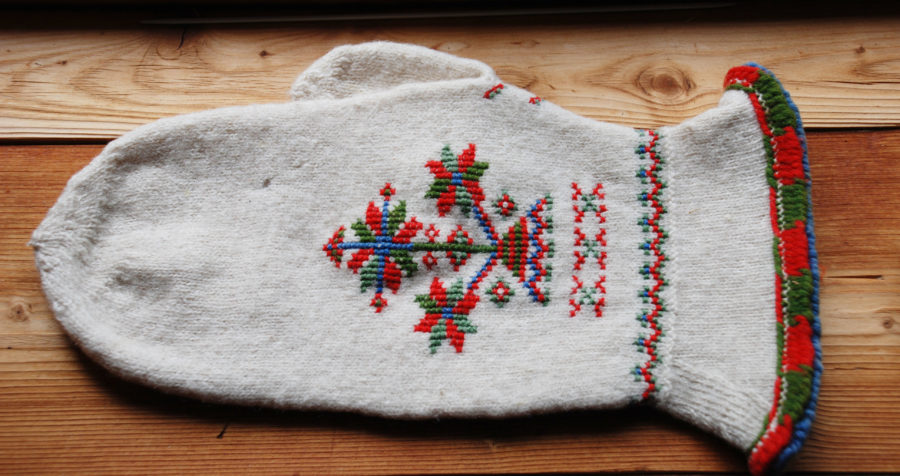The red list on traditional craft techniques

Background
| In the last decades school programs have changed and manual skills are not any longer regarded as a necessity. Also within a large organization as Norwegian Folk Art and Craft association focus change and many members are to a certain level following “craft trends” The result of this has been that several skills and craft techniques have become endangered and the knowledge and practice threatened. This is a nation-wide challenge. In some specific crafts, only a very low number of practitioners are still active. In 2012 the organization decided to introduce the Red list as an awareness raising activity among all our 375 local branches. This awareness raising is important also regarding our craft shops Husfliden. It is important that the 36 shops, all members of the association can provide the local groups and craft masters with materials and tools they need in their practice. In addition, our 19 professional craft consults are both encouraging and inspiring the voluntary working branches of the association in their search for almost extinct craft knowledge. A steady repeated message; You are doing a very important job, and: You do a good job! Your activity makes a difference for traditional craftsmanship in Norway Caption above: Stasvotten – locally designed mittens for festive occations. Photo: Møre og Romsdal Husflidslag |
Objectives
- To raise awareness about local and endangered traditional craft techniques
- To elaborate and revitalize handicraft skills at a local level,
- Facilitate arenas and processes for defining, documenting and practicing traditional craft techniques and expose and transmit the knowhow to younger persons. To revitalize and strengthen the sense se of identity and unicity expressed in local craft techniques.
- To encourage and develop a locally initiated process of engagement and involvement, the boarder this process goes , the more activity gets into it. Our local branches are inspired by each other, they learn from each other and the action is hopefully more and more running developing on its own local defined premises.
How it was done
Our professional craft consultants are giving the initial “ kick off” of the activity. Often, this happens inter alia at regional seminars. By demonstrating what already is at the Red list, the discussion take off very actively.
We have stimulated our practitioners to cooperate locally and regionally with other organizations, with schools, museums etc.

Willow flute making. A red list initiative from Telemark. Photo: Telemark Husflidslag
We encourage them to write about their defined Red list skill and techniques in the local newspapers etc.
Several of our local brances have made films, DVD, powerpoint presentations, written publications, teaching materials and courses in their Red-list technigue.
We have built a web page based inventory showing the local actions on the main homepage for Norwegian Folk Art and Craft Association. This inventory is continuously being updated.
The action is primarily connected with traditional craftsmanship. But in all craft practice there is a stage of preparing – you have to know how to get your materials suitable for what you intend to make. This means that you have to have good skills about natural recourses such as, wool, wood, dying with wild plants, growing linen etc. This is all about knowledge and practice concerning nature and the universe. You also have to know the correct words and expression in your practice, which include a necessity for a linguistic approach.

Tools used for making traditional drinking vessels, called “ølhøner”. Photo: Bærum Husflidsforening
Key factors
1. Communication
Centrally presented a clear and defined information about the aim of the activity.
2. Educational activities
Our core and greatest effort are the classes that takes place in our 377 local branches, all over Norway. We are Norway’s largest organizer of adult training courses of folk handicraft skills. We offer approx. 2500 courses per year, and about 15 000 people yearly attend our local and regional classes. These classes cover a variety of handicraft traditions within the following main categories: textile, woodcraft and color and design. A focal point on the agenda for both local branches and the central administration in the years to follow will be safeguarding the most endangered hand craft techniques and ensure recruitment of instructors. But neither the teachers nor the students of these techniques are of the younger generation, and this makes the knowledge vulnerable.
3. Handicraft masters
Among our members are 138 professional handicraft masters, who fully or partially make a living out of handicrafts. It include bunad manufacturers, silver smiths, weavers, wood carvers and more. They make sure we have a vital and continually developing field of handicrafts and folk art.
4. Enhancement of trade
A living tradition requires the possibility to make a living out of craft products and skills. We seek to stimulate and generate the best possible conditions for our folk handicraft stores and professional craftsmen. Included in this work are workshops, enhancement of handicraft skills, handicraft markets and scholarship awards.
In the future, we believe that hand craft will have a bigger importance than ever, because the products both are made to last and made of materials from the nature.

